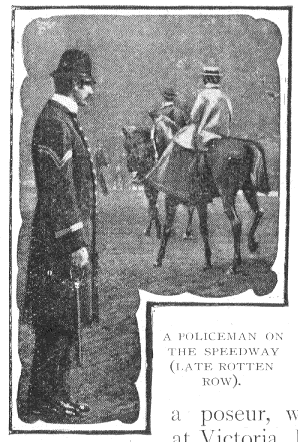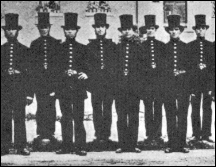London Metropolitan Police
Links
Victorian London: an excellent collection of contemporary pieces about the police. Follow the links on the home page - personal accounts, facts and articles from contemporary writers
The Police Gazette: The British Newspaper Archive has searchable copies of The Police Gazette. Also available on FindmyPast.
National Archives: The study guide to what records exist, where they are and how you can get copies
Wikipedia: A fairly comprehensive history of the London Metropolitan Police Force
Victorian Web: In an article entitled How Safe was Victorian London? Jacqueline Banerjee answers the question she poses.



One thing to note is that The London Metropolitan Police does not include the City of London Police, which, to this day, maintains a separate identity.
Prior to 1829 there was not much law and order in London. What there was was provided by a variety of bodies in a somewhat piecemeal fashion. There were volunteer watchmen and constables, the Bow Street Runners, and, of course, the Army when things got really out of hand. Suffice to say crime went relatively unchecked and there was not a great deal of security. Sir Robert Peel, in 1829 was responsible for the passing of the Metropolitan Police Act, which led to the formation of the force - the Peelers. The photograph at the top of the page and the other pictures at right, are of Peelers - notable for their large top hats, which could double as a step on which to stand! They were armed with truncheons and a rattle to draw attention. In 1868 the hat was changed to the one we recognise and associate with the London bobby, and the rattle was replaced with a whistle. The organisation of the force - the Peelers at that time - was described in 1865 in Cruchley's London in 1865 : A Handbook for Strangers:
“The Metropolitan Police force consists of 6295 men; the City Police Force (under its own Commissioner) of 608 men; in all, 6903. The average yearly expenditure is 528,000l., provided for by an assessment of 8d. in the pound, on the parish rates. The Metropolitan Police Force is distributed into twenty-two divisions, denoted by the letters A,B,C,D,E,F,G,H,I,J,K,L,M,N,P,R,S,V,W,X,Y,Z. They wear a plain blue uniform, with their number and the letter of the division on the coat-collar. When on duty, each policeman is distinguished by a blue-and-white striped cuff, and is furnished with a baton, a rattle, a lantern, an oil-skin cape, and a long great-coat. He receives from 14s. to 22s. per week, with an allowance of coals and candles; and his hours of duty average twelve daily. During two months out of three, each policeman is on night-duty (from 9 p.m. to 9 a.m.). After a certain probation, the Constable is promoted to Sergeant, Sergeant to Inspector, Inspector to Superintendent; receiving, of course, additional pay.”
As always, not being an expert, I am not going to give much actual information here. My aim is to give a very brief overview, and to provide links to the people who really do know - the experts, the organisation itself and the writers of the time.
Since that time the force has expanded considerably, they are rather better paid and the range of duties they undertake has also proliferated. There were no detectives originally, but now, of course, there is a whole portion of the police force dedicated to investigation rather than enforcement, and the crimes they investigate continue to change and evolve - cyber crime anyone? But at heart, the police are there to do what they were initially set up to do - maintain law and order, making it safe for the average citizen to live in and walk the streets of our cities - and this means controlling crowds, demonstrations and drunks, catching criminals, patrolling the streets, preventing accidents and controlling accident scenes, and offering support to those in trouble. It’s a stressful, but crucial job in today’s urbanised world.
Their reputation as an efficient and fair-minded force has remained, more or less unscathed, to the present day. Of course there have been times when they have deservedly received bad press, and, yes, of course there have been corrupt police and there probably always will be. It sort of goes with the territory. But they have been an effective force for over a century now - their contribution in wartime, in helping people, preventing crime and looting, must have been enormous. The London bobby still exists, albeit in a rather tougher world and with rather more effective defence mechanisms - here they are pictured below patrolling the streets of Brixton. Let us hope that our ancestor, John James Magee was one of the good guys.






